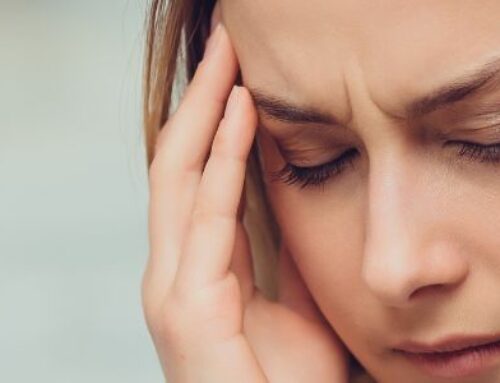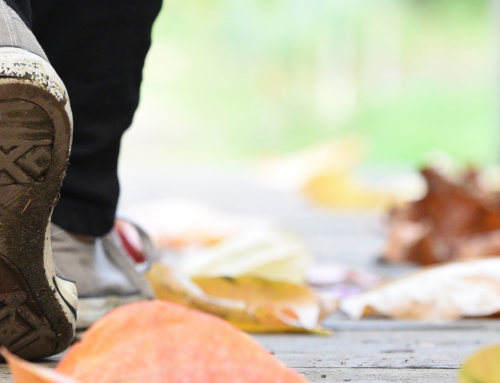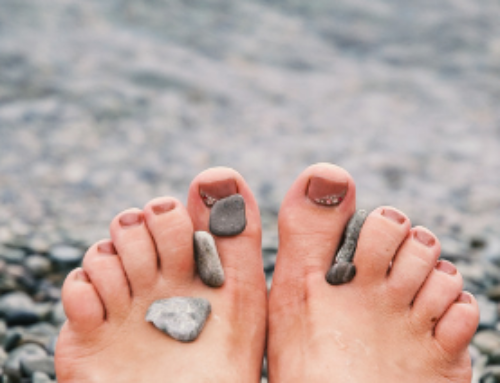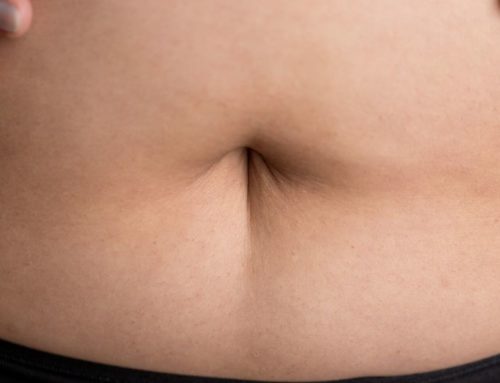For me, taking a holistic approach to benign tumors of the uterus includes co-developing a wellness plan rich in Reflexology, herbal medicine, Aromatherapy, and lifestyle health.
Fibroids occur in about 30% of women aged 35, and that number grows to nearly 80% by age 50. Known also as leiomyomas and myomas, these benign (non-cancerous) tumors can grow on the inside, outside, and within the smooth muscle walls of the uterus. These tumors are described as “firm masses of smooth muscle encapsulated in compressed muscle fibers,” in my copy of Ross and Wilson Anatomy & Physiology in Health and Illness, and can range in size from an apple seed (0.5 cm) to a watermelon (40 cm).

Creative Commons image by Bruce Blaus
Some women with myomas have minimal, if any, symptoms while others experience symptoms that interrupt their day-to-day activities. My approach to supporting someone with a diagnosis of fibroids will range depending on the kind of symptoms experienced and the individual’s wellness goals. My clients with a diagnosis of fibroids have expressed the following symptoms to me:
- Abdominal swelling
- Weight gain
- Cramping in the uterus
- Sensation of heaviness and/or pressure in the pelvis
- Low back pain
- Heavy menstrual bleeding and/or spotting and bleeding between periods
- Fatigue and shortness of breath from heavy bleeding
- Crowding of nearby organs, like the bladder and sigmoid colon, which can lead to increased urination and constipation
- Infertility in the case of fibroids that block the fallopian tubes and prevent the sperm and egg from meeting
- Fetal loss in which the uterus struggles to retain a pregnancy
Based on this range of symptoms I help clients map out a wellness plan that addresses their unique wellness goals and collection of symptoms. To give you an idea of the most common ones I’ve broken them down into body systems or regions.
Supporting the Endocrine System

Illustration of a fibroid pressing on the sigmoid colon from The Diagnosis of Diseases of Women published in 1905
Uterine fibroids have been found to be susceptible to estrogen and progesterone (Moravek et al 2015) as well as testosterone (Wong et al 2016). In fact, fibroids can make their own hormones, mainly estrogen, which can impact other hormones circulating in the bloodstream.
In Reflexology we have a technique known as linking in which the practitioner emphasizes a connection between two or more reflex areas. Linking techniques are commonly used in sessions for those experiencing fibroids, especially when the fibroids are considered to be hormone dependent. Some common linking approaches in a Reflexology session for fibroids would be:
- Hypothalamus-Pituitary-Adrenals-Ovaries – the hypothalamus and pituitary synergistically organize estrogen, progesterone, and testosterone production which are produced in the ovaries and adrenals.
- Ovary-Uterus – a balancing hold.
- Liver-Sigmoid Colon-Kidneys – where old hormones are metabolized and/or removed as waste from the body.
Cardiovascular System Support
Dutch researchers (Haan et al, 2018) found women diagnosed with uterine fibroids had a higher risk of having high blood pressure, high cholesterol, as well as an increased marker for cardiovascular disease (CVD). In a wellness plan supporting a client with this diagnosis I would want to give some extra TLC to the cardiovascular system reflex areas in their Reflexology sessions. Phytotherapy would be a welcome addition to self-care at home and might include:
- A bespoke aromastick to support the physical heart and the energetic heart (e.g. heart chakra).
- Delicious tisanes featuring red herbs such as of hawthorn berry, hibiscus, and rooibos.
Heart-healthy, nourishing meal plans a la the Mediterranean diet might also feature in the lifestyle portion of our wellness plan together.
Nourishing the Pelvis
The lower abdomen deserves a lot of care in the case of symptomatic fibroids — easing discomfort, bloating, constipation, pressure, frequent urination, and so forth. In Reflexology the clear choice here is to devote some extra time to the reflex areas of the pelvis and lower abdomen.
In the feet these regions of the body map are mirrored in the following locations:
- On the plantar surface, or sole, of the heel up towards the mid-arch
- Along the lateral side of the heel towards the outer malleolus
- Along the medial side of the heel towards the inner malleolus
I also find most of my clients benefit from bespoke aromatic castor oil packs done at home between their Reflexology treatments in which the packs are applied to the lower belly, covered with a barrier, and draped with a heated pad. While it is a bit sticky and messy the results have shown clients experience a decrease in symptoms. It really is a lovely self-care routine for home though.
Herbal and aromatic hip baths are another favorite of mine to recommend for self-care at home.
Eliminatory Organ Support

Illustration of a fibroid pressing on the bladder from The Diagnosis of Diseases of Women published in 1905
In a Reflexology session I would emphasize the digestive system reflexes for clients experience crowding of the uterus leading to constipation or the urinary system if the crowding is leading to an increased frequency in urination. These body systems would also benefit from support to help them do their job in removing old hormones from the system. Self-care approaches might include a bespoke abdominal oil for self massage, an herbal tisane to support the urinary system, or a meal plan to increase fiber intake for a sluggish digestive tract.
General Support for the Fibroid Client
I’d recommend Reflexology sessions no fewer than every two weeks at the beginning of a wellness plan so the treatments have a chance to build on each other. We can certainly time the appointments so they target some key phases of discomfort such as near ovulation and the bleeding portion of the menstrual cycle. Another consideration for scheduling Reflexology sessions would be before or after a procedure like a diagnostic laparoscopic surgery or a myomectomy that removes one or more fibroids. Sessions around a procedure are designed to decrease stress and increase comfort.
For women experiencing heavy menstrual bleeding with their fibroids I recommend an herbal blood builder syrup made with supportive foods and herbs like molasses, prunes, yellow dock, and goji berries. A commercial liquid Iron I like is made by Gaia and features nettles and beets.
Ready to get started on co-developing your fibroid wellness plan? Head over to my online scheduler to grab an appointment time.
References:
- Waugh, A., & Grant, A. (2014). Ross & Wilson Anatomy and Physiology in Health and Illness 12th Edition. Elsevier Health Sciences.
- Moravek, M. B., & Bulun, S. E. (2015). Endocrinology of uterine fibroids: steroid hormones, stem cells, and genetic contribution. Current Opinion in Obstetrics & Gynecology, 27(4), 276.
- Wong, J. Y., Gold, E. B., Johnson, W. O., & Lee, J. S. (2016). Circulating sex hormones and risk of uterine fibroids: Study of Women’s Health Across the Nation (SWAN). The Journal of Clinical Endocrinology, 101(1), 123-130.
- Haan, Y. C., Diemer, F. S., Van Der Woude, L., Van Montfrans, G. A., Oehlers, G. P., & Brewster, L. M. (2018). The risk of hypertension and cardiovascular disease in women with uterine fibroids. The Journal of Clinical Hypertension, 20(4), 718-726.









Leave a Reply